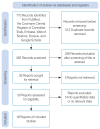Efficacy of Steroid-Impregnated Spacers After Endoscopic Sinus Surgery in Chronic Rhinosinusitis: A Systematic Review and Meta-Analysis
- PMID: 36791807
- PMCID: PMC10208850
- DOI: 10.21053/ceo.2022.01718
Efficacy of Steroid-Impregnated Spacers After Endoscopic Sinus Surgery in Chronic Rhinosinusitis: A Systematic Review and Meta-Analysis
Abstract
Objectives: The aim of this study was to compare the effect of steroid-impregnated spacers to that of conventional management after endoscopic sinus surgery (ESS) in patients with chronic rhinosinusitis (CRS).
Methods: Six databases were searched from inception until November 2022. Sixteen studies were found that compared the improvement of chronic sinusitis-related symptoms and postoperative outcomes between a steroid-impregnated spacer group and a control group (non-steroid-impregnated spacers). The Cochrane risk of bias tool (for randomized controlled studies) and the Newcastle-Ottawa Scale (for non-randomized controlled studies) were used to assess the quality of the works included.
Results: Regarding the endoscopic findings, the degree of mucosal edema, ethmoid inflammation, crust formation at 2-3 months postoperatively, nasal discharge, polyposis, and scarring/synechia were significantly lower in the steroid-impregnated spacer group. The steroid-impregnated spacer group also showed significantly lower Lund-Kennedy scores and perioperative sinus endoscopy scores than the control group at 2-3 weeks postoperatively. Furthermore, the steroid-impregnated spacer group had lower rates of adhesions, middle turbinate lateralization, polypoid changes, the need for oral steroid use, the need for postoperative therapeutic interventions, and lysis of adhesions than controls. However, no significant between-group differences were found in short-term (2-3 weeks postoperatively) endoscopic findings regarding nasal discharge, postoperative crusting, polyposis, or scarring/synechia.
Conclusion: Steroid-impregnated nasal packing reduced the rates of postoperative intervention and recurrent polyposis and inflammation in CRS patients undergoing ESS.
Keywords: Nose; Operative Surgical Procedures; Sinusitis; Stents; Steroids.
Conflict of interest statement
Sung Won Kim and Do Hyun Kim are editorial board members of the journal but were not involved in the peer reviewer selection, evaluation, or decision process of this article. No other potential conflicts of interest relevant to this article were reported.
Figures



Similar articles
-
Efficacy of Absorbable Steroid-Impregnated Nasal Packing in Functional Endoscopic Sinus Surgery for Chronic Rhinosinusitis: A Systematic Review.Laryngoscope. 2021 Aug;131(8):1704-1714. doi: 10.1002/lary.29350. Epub 2021 Jan 4. Laryngoscope. 2021. PMID: 33393665
-
Absorbable Steroid-Impregnated Spacer After Endoscopic Sinus Surgery to Reduce Synechiae Formation.Ann Otol Rhinol Laryngol. 2016 Mar;125(3):195-8. doi: 10.1177/0003489415606446. Epub 2015 Sep 21. Ann Otol Rhinol Laryngol. 2016. PMID: 26391092
-
Efficacy and safety of steroid-impregnated implants following sinus surgery: A meta-analysis.Laryngoscope. 2020 Dec;130(12):2754-2759. doi: 10.1002/lary.28388. Epub 2019 Nov 22. Laryngoscope. 2020. PMID: 31755990
-
Comparison of steroid-releasing stents vs nonabsorbable packing as middle meatal spacers.Int Forum Allergy Rhinol. 2020 Mar;10(3):328-333. doi: 10.1002/alr.22492. Epub 2019 Nov 19. Int Forum Allergy Rhinol. 2020. PMID: 31742932 Clinical Trial.
-
The impact of middle meatal steroid-eluting implants on the postoperative outcomes of chronic rhinosinusitis: A systematic review and meta-analysis.Eur Ann Otorhinolaryngol Head Neck Dis. 2025 Jan;142(1):26-37. doi: 10.1016/j.anorl.2024.02.014. Epub 2024 Mar 22. Eur Ann Otorhinolaryngol Head Neck Dis. 2025. PMID: 38521652
Cited by
-
[Difficult-to-treat chronic rhinosinusitis-when the standard treatment is not effective and biologics are not available].HNO. 2024 Apr;72(4):231-241. doi: 10.1007/s00106-024-01443-w. Epub 2024 Mar 12. HNO. 2024. PMID: 38472346 Review. German.
-
Polymorphisms and NIHL: a systematic review and meta-analyses.Front Cell Neurosci. 2023 Jun 15;17:1175427. doi: 10.3389/fncel.2023.1175427. eCollection 2023. Front Cell Neurosci. 2023. PMID: 37396925 Free PMC article.
-
[Expert consensus on the application of nasal cavity filling substances in nasal surgery patients(2025, Shanghai)].Lin Chuang Er Bi Yan Hou Tou Jing Wai Ke Za Zhi. 2025 Apr;39(4):285-291. doi: 10.13201/j.issn.2096-7993.2025.04.001. Lin Chuang Er Bi Yan Hou Tou Jing Wai Ke Za Zhi. 2025. PMID: 40166868 Free PMC article. Chinese.
-
Efficacy of Platelet-Rich Plasma in the Treatment of Persistent Olfactory Impairment After COVID-19: A Systematic Review and Meta-Analysis.J Rhinol. 2024 Mar;31(1):1-7. doi: 10.18787/jr.2024.00006. Epub 2024 Mar 31. J Rhinol. 2024. PMID: 39664044 Free PMC article. Review.
-
Effectiveness of temperature-controlled radiofrequency neurolysis of the posterior nasal nerve to treat chronic rhinitis: a systematic review and meta-analysis.Eur Arch Otorhinolaryngol. 2024 Feb;281(2):537-545. doi: 10.1007/s00405-023-08242-z. Epub 2023 Sep 20. Eur Arch Otorhinolaryngol. 2024. PMID: 37728632
References
-
- Fokkens WJ, Lund VJ, Hopkins C, Hellings PW, Kern R, Reitsma S, et al. European position paper on rhinosinusitis and nasal polyps 2020. Rhinology. 2020 Feb;58(Suppl 29):1–464. - PubMed
-
- Orlandi RR, Kingdom TT, Smith TL, Bleier B, DeConde A, Luong AU, et al. International consensus statement on allergy and rhinology: rhinosinusitis 2021. Int Forum Allergy Rhinol. 2021 Mar;11(3):213–739. - PubMed
-
- Svider PF, Sekhsaria V, Cohen DS, Eloy JA, Setzen M, Folbe AJ. Geographic and temporal trends in frontal sinus surgery. Int Forum Allergy Rhinol. 2015 Jan;5(1):46–54. - PubMed

